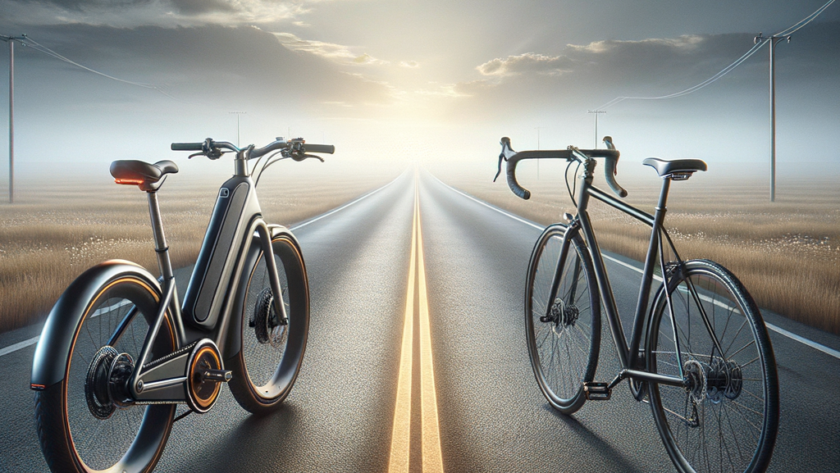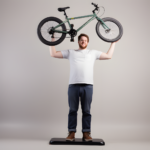Introduction: Are Ebikes Safer than Bikes?
The popularity of ebikes has been on the rise in recent years, with more and more people switching to this eco-friendly alternative to traditional bikes. However, questions have been raised about their safety and whether they are a threat to riders.
When it comes to choosing between a regular bike or an ebike, people want to know which one is safer. Safety is a major concern for cyclists as accidents on the road can cause serious injuries. Therefore, it’s important to assess the differences between ebikes and traditional bikes and determine which one is better in terms of safety.
In this guide, we will take a closer look at the topic of ebike vs. bike safety, examining the technology and infrastructure behind both types of vehicles. We will explore the structure and weight of bikes, analyzing the newer design features of ebikes that make them unique. We’ll also address how riders can control the speed and power of their ebikes. Additionally, we will analyze the efficacy and durability of ebikes as opposed to standard bicycles and examine built-in safety features. Finally, we’ll discuss the statistics related to ebike accidents and interview ebike riders and experienced bicyclists for their thoughts and experiences with ebike safety.
By the end of this guide, you should be able to make an informed decision on whether an ebike is the right choice for you. So without further ado, let’s get started!
Traditional bikes vs. Ebikes: What’s the difference?
There’s no denying that ebikes have changed the game for commuting and cycling in general. But how do they differ from their traditional, non-electric counterparts? Firstly, let’s compare the design and structure.
- Design: Traditional bikes typically have a simpler design with fewer parts and are constructed primarily of lightweight materials like aluminium and carbon fibre. Ebikes, on the other hand, come with additional parts such as the electric motor and battery, adding weight and complexity to the design.
- Structure: Since ebikes are motor-assisted, their frames need to be sturdier and more robust to accommodate the extra weight and power. While traditional bikes require less support due to their lighter frames
The next point to consider is weight. Ebikes are generally heavier than traditional bikes because of the added components. This makes ebikes somewhat harder to maneuver, making it more difficult for some riders to move them up and down stairs, for instance, or on tricky inclines. Then came the rise of the technology behind Electric Bikes.
In terms of technology difference, ebikes are fitted with an electric motor powered by Lithium-Ion batteries, which when completed cycles can take you about 100 to 200 kilometers and still at considerable speed quite enough robust to keep your commute faster, relatively of course,eBikes also adoption changing gear system like Shimano EF65 rapid-fire to accommodatate safety and standard control reason
Lastly, we can explore the specific features unique to ebikes that your typical bike wouldn’t possess, most commonly pedal assists that provide smooth alongside throttle application making remote control near to intuitive.
Overall, while there may be greater added weight and complexities to an ebike, the human-preserving technologies found on those bikes likely eliminate enough large risks faced while riding traditional bicycles. Only at substantially decreased physical injury probabilities, probably due to stopping structures or signals that ebikes created explicitly for riders.
Analyzing the Technology behind Ebikes
Ebikes are quickly arising as a popular form of transportation. With their electric motors and lithium-ion batteries, they provide a more sustainable and convenient way to travel. Understanding the technology behind these bikes is vital in determining their overall safety.
One of the primary components needed to build an ebike is the electric motor. This motor is used to assist the rider when pedaling by providing power to the rear wheel through a chain or hub motor. Many ebikes also have motors that can be activated without pedaling, allowing the rider to move forward using only the motor (known as “throttle” mode). Some models offer multifunctional pedal-assist motors, where different levels of power assistance could be selected depending on the user’s fitness level.
Another crucial component of ebikes is the lithium-ion battery technology, which provides the power to the electric motor and is rechargeable after use. Lithium-ion batteries have proven to be both reliable and safe and can offer enough power to carry the bike and rider for up to 45 miles on just one charge. The performance and lifespan of the ebikes highly depend on the quality of the lithium-ion battery, and this is one aspect you might want to look out for when choosing a reliable model.
Ebikes also come with control panels that let riders adjust the level of power assistance obtained from the electric motor depending on user needs and prevailing road conditions. Some bikes have advanced displays and sensors that facilitate automatic adjusting of the power assistance to give the most comfortable ride for passengers’ slope demands at all times.
As far as safety goes, ebikes remain considered safe if proper handling and care are exercised during use. For example, most batteries come with settings to keep batteries within a safe operational temperature range and offer rugged durability against water splash. Just like with any technology convenience, there has got to be responsibilities that come with using these high-tech machines.
In conclusion, electrical bikes come armed with sophisticated technology types compared to general-purpose bicycles, such as a state-of-the-electric drivechain, light forks as well as tires, optimized battery management systems, and central display components. It is paramount the utilization of these features are observed according to safety standards recommended by manufacturers in daily operations. Though ebikes show great potential to revolutionize cycling, their safe application remains a mix of training and tasking care, regulation implementation on a positive societal note.
How Do Ebike Users Control Speed and Power?
Ebikes are equipped with an electric motor activated by a throttle, pedal-assist mode, or both. Unlike regular bikes, ebikes offer flexibility when it comes to how and when the motor is engaged to assist the riders.
- Throttle-only – This feature allows riders to operate their bikes using only the electric motor without pedaling. A full twist of the handlebar activates the motor pushing the bike forward at full speed.
- Pedal-assist – The pedal-assist feature is designed to work in reaction with pedaling, and automatically add electric power as the rider pedals along, making the pedaling process feel much easier. Pedal-assist minimizes exhaustion, making it easy to tackle hills and cover longer distances.
Some may argue that these exciting new features put ebike riders in danger more than traditional bike riders. Inherently rebellious riders may be tempted to challenge themselves to go faster while never slowing, which contribute to risk-taking behavior around other vehicles and pedestrians.
The unique riding dynamics, especially those experienced with throttle-only, can present issues for beginners to control. Unexpected acceleration or over-trying to get started may increase the likelihood of falling and injuring riders or even innocent pedestrians.
Your safety on an ebike starts with knowing your surroundings, bike mechanics, and ensuring responsible use of the power assistance technology. Ensure your equipment is properly tuned-up and never put yourself beyond the recommended and legal weight limit the bike or particular motor has identified.
Don’t commence your first throttle-going adventure far from home. Start Slowly in area (s) where you anticipate safety, modest foot, and comparatively vital vehicle circulation and, most importantly, where throngs are fully prohibited.
Finally, mastering effective braking is necessary when riding any bike, including an ebike. Ensure you learn how braking on your bike functions, configurations, and all applications for each configuration provided. Excessive brakes or depending too much simply on the stop-effectiveness of inductive engines, without utilizing proper caution when operating at higher speeds, maybe hazardous.
Addressing Concerns About The Top Speed of Ebikes
One major concern some people have about ebikes is their speed and how it compares to traditional bikes. It’s worth mentioning that not all ebikes are created equal and some have a higher maximum speed than others.
- A traditional bike is powered solely by the rider’s pedaling. Depending on how fit the cyclist is, they can reach speeds of up to 25 mph under the right conditions such as going downhill.
- In contrast, an ebike can have a maximum speed range of between 20-30 mph depending on its class. This class rating includes Class 1 which caps out at 20 mph; Class 2 which has a top speed of 20 mph but allows the use of a throttle and Pedal Assist System (PAS); and Class 3 ebikes which can go up to 28 mph with PAS controls only.
If you’re someone who prefers slow cycling, then you may be alarmed by the speed of an ebike. However, the similarity between the two bikes in terms of speed means that an ebike won’t provide you with significantly faster overall travel time.
If anything, having an electric motor assist when cycling up hills or against strong winds will help to make up for time lost during moments like these when cycling purely traditionally. This could make your journey overall more efficient and quicker regardless of the difference in top speed compared to regular bicycles.
Ultimately, it’s essential to remember that riders must obey speed limits when cycling on public roads and pavements. Even if you can ride faster while operating an ebike, road laws and regulations put into place as preventative measures in keeping you and other cyclists safe still apply. It’s also advisable to wear appropriate protective gear like helmets, just as you would when riding any other bike.
Analyze the Braking Systems of Ebikes and Compare Them to Traditional Bikes
When it comes to bicycle safety, having an effective braking system is crucial. Both ebikes and traditional bikes have different types of brakes that operate in different ways.
A traditional bike typically has hand-operated rim or disc brakes. These types of brakes work by squeezing particular surfaces of the bike wheel to create friction, which then slows down or stops the bike’s motion.
In comparison, an ebike may have similar rim or disc brakes, but they also have additional electronic braking mechanisms built-in. Ebikes possess regenerative braking, which converts some of the energy from the bike’s momentum into electrical energy that you can store in the battery while also slowing down the bike. This type of braking is manual, meaning you regulate your slowing down based on how vigorously you apply your brakes. Other electrically powered motorcycles may have an antilock brake feature as an extra safety mechanism, which can be incredibly useful in emergency braking situations.
Overall, ebikes possess greater braking power than traditional bikes. The electric hazard has electronic sensors that calculate so-called “engine-braking,” which supports the people to slow down sooner when convenient directly from the electric motor to supervise stopping range. Moreover, if you find yourself heading at increased instability, the advanced braking process on an ebike increases your reaction time by acting swiftly and precisely, raising riders’ comfort and personal safety and ensuring a more instant reaction route.
In contrast, traditional bikes have less reliance on precise stopping, particularly during hilly terrains, showing that care often must be taken when cycling steep mountainous ranges or narrow terrain roads.
While ebikes have more efficient braking systems, safety is entirely relied on the rider’s hand and stimuli to use these controls. Thus, If used correctly, such control-based electronic props will enhance such passengers’ protection significantly; the opportunity to do higher top speed requires though following the law, instruction on when to reduce power and space should be in awareness due to potential occupancies outside the rider’s recognizable reasonings.
It is crucial for any rider, regardless of bike type, to practice safe braking habits, maintain and examine their brakes’ effectiveness, and ride defensively to avoid accidents related to braking.
Exploring the Efficiency and Endurance Differences of Ebikes vs. Standard Bicycles for Rider Safety
Ebikes are often seen as a convenient and eco-friendly alternative to traditional bikes with their electric motors offering an easier ride. But what about when it comes to efficiency and endurance on the road?
In terms of efficiency, studies have shown that ebikes are capable of traveling further and longer distances with less effort than standard bicycles. Therefore, they require less energy expenditure from riders, making them more practical and potentially safer options, particularly for commuters or individuals who may have physical limitations but still wish to enjoy cycling.
Moving on to endurance, ebikes once again prove to be reliable modes of transportation for longer trips. With pedal assistance from the electric motors, ebike riders can go the extra distance without experiencing exhaustion that could lead to accidents on the road.
Another consideration is the terrain. Ebikes are able to tackle hills and slopes with greater ease than traditional bicycles, which could be a safety concern in some areas. When traversing particularly hilly terrain, poor balance or inadequate endurance on a traditional bike can impair the cyclist’s ability to brake and manoeuvre if needed, while electric assist can improve stability and reduce risks of falls.
- So, what are the implications of these differences in efficiency and endurance for rider safety overall?
- Some concerns arise surrounding the possibility of speeding and reckless riding – especially among users with little experience – paired with the assistance of ebikes, which translates into higher speeds per hour for users enjoying the assistance. The result is that riders are capable of speeds often exceeding typical bike lanes’ posted speed limits. While providing that voluntary throttle creates extra speed for users as soon as they twist the switch-type throttle (activators), smaller measures meant to monitor and switch off this conjoined feature are being undertaken to mitigate the excessive risks of speeding on public streets and bike paths managed by the federal government.
- Additionally, because the battery power of ebikes eventually falls below certain levels after hours of exhaustive use, abrupt performance losses are made evident after long riding times. This could impair effectiveness in several aspects like reaching speeds required to circumnavigate fast cars, or suddenly rendering blank human power. Users newer to ebikes who point prematurely run out of charge aren’t familiar with the machine’s manual skeleton, though perhaps for prevention plans, a small EPA for better upkeep of the machinery ensuring longer battery life can help prevent haphazard usage.
- However, riders of all experience levels stand to benefit from the efficiency and endurance capabilities that ebikes offer compared to traditional bikes, providing riders more options to consider based on their particular trip angle.
Ultimately, different situations do call for unique vehicles differences, but depend on the conditions and commitments it is statistically accurate that minor circumstances mentioned earlier indeed play vital roles to not dismiss ebikes outright as immediately less secure or health-endangering.
Highlighting some built-in safety features of Ebikes
Ebikes offer unique safety features that traditionally made bicycles don’t have, such as turn signals and enhanced lighting that run even during the day. Before we dive into the technical stuff, let’s discuss the significance of these features.
Turn signals found on most modern ebikes are an essential safety component that biking enthusiasts couldn’t have thought of a century ago when traditional bikes were prevalent. With turn signals, you signal other drivers, adding to your traffic visibility while turning towards a direction. These turn signals are particularly handy in crowded cities with heavy traffic, will signaling lets nearby riders and motorists know what you’re doing, creating a safer scenario.
Incorporated with lights, edbike safety systems escalate these features to new heights. Ebike lights go beyond the traditional flick of a switch, such that their lighting components power always-on LED floodlight performances. Always-on-endilight features illuminate throughout the day to lead the way, help onlookers, sunrise or shine. Flashy lights help bikers stay visible even during scenarios with low visibility.
This does not mean non-Ebikes lack any good safety features; Manufacturers adhering to European bicycle safety regulations guarantee essentials, like active front and easy-grasping brakes to help bikers come to a standstill during rush moments.
Game-changer technologies, such as pedals assisted-stemming torque sensors, responsive brake systems brings about immense safety value addition to ebikes. Designed for a seamless riding experience, modern bike manufacturers employ hydraulic disks that bring your rolling machine to a halt much faster than the conventional pads used in rims.
Rewriting cyclist safety, ebikes pack intriguing features against harsh weather conditions comprehensively – different integrated brake features prompts safety conduct into ebinding journey experiences. For starters, reaching the desired slowdown speed much faster takes less physical space on either bad or good terrain all over. Multisensors this type boost automotive confidence significantly.
- Led lights always on during riding
- Signal-lights for turning right/left in crowded roads
- Secure responsive braking systems that values rider’s safety
- Throttle controllers allow integration of better bike response times while advancing on busy highways for more extended periods
In conclusion, manufacturers of so-called electric bikes implement components like hydraulics and lithium-ion batteries to provide unmatched biking functions for beginner riders, intermediate-level. The above technology blends in fortuitously to provide seamless handling capabilities practically guarantee zero accidents; You’ve got the undivided attention-rested and comfortable hand /vision coordination blend.
How Infrastructure and Legislation Can Affect the Safety of Ebikes on Public Roads and Pavements
Ebikes, like traditional bicycles, are legally allowed to be used on public roads and pavements without a license or insurance. However, because ebikes rely on an electric motor, they are subject to different regulations than bicycles.
Infrastructure also plays a role in the safety of ebikes. For example, bike lanes and paths specifically designed for bicycles can make it safer and more convenient for ebike riders to commute or ride for leisure. On the other hand, the lack of proper infrastructure can create more hazards for riders, particularly when vehicles and bicycles share the road.
Legislation varies by country and even by state or province. In some areas, there are clear definitions for different types of ebikes based on their speed and power output. For example, in the United States, if an ebike can reach speeds up to 28mph, it may not be considered a bicycle and instead may be classified as a low-power motor vehicle in certain jurisdictions.
The way ebikes are ridden and the potential risks for riders can also be affected by legislation. For example, many places require helmets for riders under a certain age or when riding at faster speeds. Some jurisdictions also have rules about riding on sidewalks or using hand signals to indicate turns.
- Cities and countries with more frequent bike lanes and bicycle specific path designs have been shown to reduce cycling accident rates.
- The main reasons cycling accidents happen on public roads is due to motorists overtaking at close proximity, road debris or potholes, and weather when road grip is suddenly compromised – which affects bicycles and ebikes in exactly the same way..
In conclusion, the safety of ebikes on public roads and pavements is influenced by both infrastructure and legislation. While an ebike may have built-in safety features that make them arguably safer than traditional bicycles, responding to the needs of specific types and power outputs could prompt additional safety features as new cycles classify under well-understood legal structures. In turn boosting infrastructural elements such as exclusive bike lanes thusly making it more accessible for both leisure and commuting purposes.
Analyze statistics related to ebike accidents and compare them to traditional bicycle accidents
According to recent studies, there is no clear evidence to suggest that ebikes are safer than traditional bikes. Although ebikes are generally heavier and equipped with built-in safety features like turn signals and lighting, the risk of accidents seems to be fairly similar when compared to regular bicycles.
In fact, some statistics suggest that ebikes could potentially be more dangerous due to their higher average speed. Ebikes in certain countries are legally permitted to reach speeds of up to 28 mph (45 km/h), which can pose a significant danger if the rider is not experienced and cautious on the road.
However, it’s important to note that worldwide data on ebike accidents is limited and doesn’t tell the whole story. In North America, only around 1% of cyclist fatalities were associated with ebike use. The Royal Society for the Prevention of Accidents in the UK have reported no ebike fatalities on record from bike paths or roads.
Overall, much of the danger associated with bicycling comes down to how well riders make informed choices and follow the rules of the road. To stay safe while biking, both traditional bicyclists and ebike riders should always wear helmets and have lights installed to increase visibility, ride defensively and prioritize accuracy and awareness.
While there may not be substantial evidence indicating whether ebikes are indeed safer than traditional bikes, obtaining proper training and certification, as well as using careful, responsible riding practices with patiently adherence to roadway laws, ultimately contribute for a firsthand knowledge of potential patterns in accidents and translates to real, tangible safety improvements. Riding experience coupled with knowledge of craft and upkeep prove paramount to reduce instances of chance / unintended injuries.
Interview with Experienced Cyclists and Ebike Riders on Their Thoughts About Safety
To get a personal insight into the topic of ebike safety, we talked to experienced cyclists and ebike riders. They provided firsthand experiences and shared their thoughts about how safe ebikes are compared to traditional bikes.
- Samuel: A bike messenger who has been using traditional bikes for over 15 years and recently switched to an ebike. Samuel never had any major accidents and mentioned that despite the added motor power of the ebike, he feels that it’s generally safer, especially when carrying heavier packages. He also mentioned that – similar to checking mirrors and blind spots while driving a car – the speed of the ebike requires riders to stay alert and aware of their surroundings at all times.
- Emily: A recreational cyclist for the past five years who decided to buy an ebike after some research. Emily values the extra assistance an ebike provides to manage tough terrain or long commutes, and considers it safer than a traditional bike because they can maintain a steady pedal cadence without getting too tired. “It’s important to remember that just like any mode of transportation – whether it be cars, buses, bicycles or ebikes – it is never 100% safe. On the other hand, the many practical features of the ebike, like lights, assistive power, parking sensors and turn signals might even make them a bit safer than traditional bikes in certain scenarios and settings.”
- Alex: A mountain biker who switch to an ebike due to a disability that impacted his ability to handle challenging terrains. Despite being a proficient rider, Alex has had minor accidents on his standard bike, which remind him of the ease that a small mistake could quickly turn into a dangerous situation. He mentioned that he formulated his riding habits and supporting gear for mountain biking, pedelec speed regulations or lithium-ion backup longer rang materials are functionaries that facilitate smooth rides which was not a feasible option on a traditional bike.
The feedback we got from these riders suggests that while there’s still an element of risk present when it involves any type of cycling, ebikes do have practical features that enhance safety. Features like added power assistance render conquering hills less labor-intensive, disc brakes for stopping torque and instant control or more extensive fat tires that aid in balance consider important merits of ebikes. Additionally, lights, turn signals and proximity sensing may undeniably improve visibility and signaling when making turns or changing lanes. When combined with increased awareness, attentiveness and physical readiness being thrown into the mix, eBiking will continue carving its selfless niche in urban exercises, expediting commutes, providing adaptive recreational works for anyone irrespective of restriction limitations
Conclusion – Are Ebikes Safer Than Bikes?
After carefully analyzing the similarities and differences between traditional bikes and ebikes, it seems that both types of bicycles offer their own unique benefits and risks. While ebikes do provide some added safety features such as signaling and lighting, they are also heavier and can travel at faster speeds compared to standard bicycles. Studies have shown that ebikes have a comparable accident rate to traditional bikes, however, this rate may change as more riders switch to ebikes.
- In terms of control, ebike riders have the ability to adjust the level of motor power and speed, which can lead to greater maneuverability but also comes with a requirement for increased rider awareness and skill.
- Battery-powered ebikes have advanced over the years making the technology efficient and reliable, yet, there is still concern with the battery fire risk from damaged or restricted cells within the battery packs, thus ebikes still receive much scrutiny.
- Braking systems of ebikes tend to be different, designed to handle the increase in weight and velocity (up to 28 mph) required in comparison to traditional bikes venturing regular speeds in the range of 20 mph number thereby aid in slowing and stopping an ebike with greater efficiency.
Infrastructure and legislation play a vital role in ensuring the safety of not only ebikers but cyclists too. Laws around the use of bike lanes, rules respecting helmets and luminosity in lighting conditions, as well as legal speed limits, and notifications for brakes are very important regulation areas to maintain a focus on.
The conclusion remains subjective, but soundly argued by either definition. Traditional bikes seem safer and easier because they promote manual reliance and call for greater collaboration with the condition of no electronics, but likewise, ebikes allow autonomy and growth by providing a chance to venture and be more communicative with your biking troupe. The verdict is that safety in riding should never replace autonomy of adventure or stifle innovation, but instead learn to compromise, we suggest understanding your bike’s potentially unforeseeable shortcomings and staying up-to-date with necessary legislation about all bike safety-related expectations that govern you as a cyclist – hybrid cycler or ebiker, so we can enjoy our scenic routes safely.
FAQs
- Q: Are ebikes safer than bikes?
A: The answer to this question is complex and ultimately depends on various factors such as the rider’s experience, infrastructure, and adherence to local laws. Here are some factors to consider:- Ebikes have built-in safety features such as turn signals and lighting
- Ebikes allow riders to control the speed and power of their bikes, which can help with safety on hills and tough terrain
- Ebikes can go faster than regular bikes and may require more caution on the rider’s part
- Ebikes have a heavier structure and weight, potentially leading to more serious injuries in the event of an accident
- Infrastructure and legislation can affect the safety of ebikes on public roads and pavements
- Statistics show ebike accidents occur less frequently but tend to be more severe
- Q: What is the difference between a traditional bike and an ebike?
A: Traditional bikes rely on the rider’s physical exertion to move while ebikes are equipped with an electric motor and Lithium-Ion batteries to assist the rider’s pedaling. Ebikes are generally heavier and have a bulkier structure than standard bikes due to their electric components. - Q: How do ebike riders typically control the speed and power of their bikes?
A: Ebike riders can typically control the speed and power of their bikes in one of two ways: through pedal-assist modes that provide a boost when pedaling or manually adjusting their power through a control panel mounted on the bike’s handlebars. - Q: Do ebikes have safety features that traditional bikes don’t?
A: Yes, some ebikes come with built-in safety features such as turn signals and lighting that aren’t typically found on standard bikes. - Q: Are there any concerns about the top speed of ebikes?
A: Yes, some may argue that ebikes going faster than traditional bikes can cause safety concerns, especially when sharing the road with cars. - Q: How do braking systems on ebikes compare to those on traditional bikes?
A: Braking systems on ebikes generally work in the same way as traditional bikes, with hand brakes on the handlebars that activate the bike’s brake system. However, some ebikes may also have a motor cut-off feature to assist with braking. - Q: How does endurance and efficiency on ebikes compare to standard bicycles?
A: In general, ebikes are more efficient than traditional bikes due to their electric components, which means riders can travel further and use less physical energy. However, because ebikes are heavier, they may not have the same endurance as standard bikes and need to be recharged more frequently.
comments: 0




